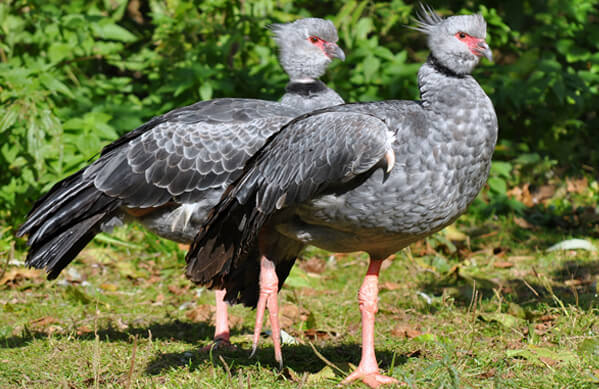 The Southern Screamer (also known as the Crested Screamer) may look ungainly at first glance, with its big body, disproportionately small head, and thick legs. But this large, gray marsh bird, closely related to geese and other waterfowl, is actually a strong swimmer and flier.
The Southern Screamer (also known as the Crested Screamer) may look ungainly at first glance, with its big body, disproportionately small head, and thick legs. But this large, gray marsh bird, closely related to geese and other waterfowl, is actually a strong swimmer and flier.
Screamers are the “guard birds” of their habitats; their trumpet-like calls can carry for several miles, warning other birds, such as Blue-throated Macaw, Orinoco Goose, and Streamer-tailed Tyrant, of approaching danger.
Still a common species, the Southern Screamer (and many other species of waterfowl, such as Wood Duck) faces threats from habitat loss caused by human activities, including draining wetlands for agriculture, logging, pollution, and road construction.
Spongy Meat Deters Hunting
Although these large and conspicuous birds would seemingly make a good meal, they are not often hunted. Apparently, their flesh — riddled with air sacs — is highly unpalatable to people! However, chicks are sometimes taken by local people and raised with chickens to act as "watch birds" and defend the domestic fowl from predators.
Southern Screamers are armed with two curved, sharp carpal spurs on each wing. Male Southern Screamers that are not paired off use these spurs to fight for females, while both sexes use them to protect their territory from predators or in disputes with other screamer pairs.
This species does not migrate. The birds are quite capable of flight but prefer to move about on the ground or in the water. Long toes, lightweight bones, and the air sacs under the skin are all adaptations to the species' semi-aquatic lifestyle.
(Audio by Peter Boseman, XC220918. Accessible at www.xeno-canto.org/220918)
The Southern Screamer establishes monogamous relationships that last its lifetime, around 15 years. The nest, built by both parents, is a well-hidden platform of reeds, straws, and other aquatic plants near the water. The couple shares incubation and chick-raising duties.
With a mostly herbivorous diet, this species eats mostly plant stems, seeds, roots, and leaves, though it will sometimes take invertebrates and other small animals, particularly when feeding young.

Southern Screamer and chicks, Daniel Alarcon, Asociación Armonia
Seeing the Southern Screamer
Southern Screamers can be found on the savannas and wetlands of Bolivia's Barba Azul Nature Reserve, which protects over 27,000 acres of habitat and supports an estimated 250 bird species. The reserve is also an important stopover for migratory shorebirds such as the Buff-breasted Sandpiper and is the world's only protected area for the Blue-throated Macaw.
ABC helped Bolivian partner Asociación Armonía create the reserve in 2008 to reverse the decline of the macaw and restore the degraded landscape. A research station and four cabins at the reserve provide housing for visitors. Learn more about seeing this special place at ConservationBirding.org.
Donate to support ABC's conservation mission!



















































